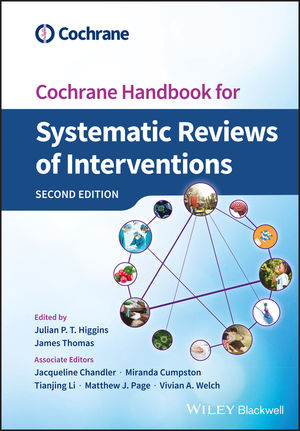Cochrane Handbook for Systematic Reviews of
Interventions, 2nd ed.
| 著者 | : J.P.T.Higgins & J.Thomas (eds.) |
|---|---|
| 出版社 | : JOHN WILEY & SONS, LTD. |
| ISBN | : 978-1-119-53662-8 |
| ページ数 | : 694pp. |
| 出版年 | : 2019年 |
在庫
定価15,862円(本体14,420円 + 税)
※在庫表示「なし」の商品は海外発注にて注文を承ります。概ね4〜6週間で取寄可能です(「近刊」の商品は刊行後の入荷・発送になります)。
なお、海外発注後のキャンセルはお受けできかねますのでご了承ください。
- 商品説明
- 主要目次

本書は、医療介入の効果に関するコクランレビューの作成およびメンテナンスにおける、重要なガイダンスである。提示している原理と手法の多くは、医療以外の領域におけるシステマティックレビューにも適用でき、コクラン以外のシステマティックレビュー作成者にとっても興味深いものとなっている。
全面的に改訂された新版では、ネットワークメタアナリシス、公平性、複雑な介入、ナラティブシンセシス、自動化など、幅広いトピックに対応するシステマティックレビューの手法について、包括的かつ新たな情報を収載する。
作成者や査読者、その他のコクランレビューに関心のある人々のために書かれた本書は、システマティックレビューの役割を理解し、医療研究を批判的に評価し実施するための貴重な情報源であり続ける。
Part One Core methods 1
1 Starting a review 3
1.1 Why do a systematic review? 3
1.2 What is the review question? 4
1.3 Who should do a systematic review? 5
1.4 The importance of reliability 7
1.5 Protocol development 8
1.6 Data management and quality assurance 11
1.7 Chapter information 12
1.8 References 12
2 Determining the scope of the review and the questions it will address 13
2.1 Rationale for well-formulated questions 13
2.2 Aims of reviews of interventions 15
2.3 Defining the scope of a review question 16
2.4 Ensuring the review addresses the right questions 21
2.5 Methods and tools for structuring the review 24
2.6 Chapter information 29
2.7 References 29
3 Defining the criteria for including studies and how they will be grouped for the synthesis 33
3.1 Introduction 33
3.2 Articulating the review and comparison PICO 35
3.3 Determining which study designs to include 51
3.4 Eligibility based on publication status and language 60
3.5 Chapter information 61
3.6 References 61
4 Searching for and selecting studies 67
4.1 Introduction 68
4.2 General issues 68
4.3 Sources to search 70
4.4 Designing search strategies 79
4.5 Documenting and reporting the search process 90
4.6 Selecting studies 92
4.7 Chapter information 99
4.8 References 99
5 Collecting data 109
5.1 Introduction 109
5.2 Sources of data 110
5.3 What data to collect 114
5.4 Data collection tools 125
5.5 Extracting data from reports 130
5.6 Extracting study results and converting to the desired format 136
5.7 Managing and sharing data 136
5.8 Chapter information 137
5.9 References 137
6 Choosing effect measures and computing estimates of effect 143
6.1 Types of data and effect measures 143
6.2 Study designs and identifying the unit of analysis 145
6.3 Extracting estimates of effect directly 148
6.4 Dichotomous outcome data 150
6.5 Continuous outcome data 156
6.6 Ordinal outcome data and measurement scales 168
6.7 Count and rate data 170
6.8 Time-to-event data 172
6.9 Conditional outcomes only available for subsets of participants 173
6.10 Chapter information 174
6.11 References 174
7 Considering bias and conflicts of interest among the included studies 177
7.1 Introduction 177
7.2 Empirical evidence of bias 180
7.3 General procedures for risk-of-bias assessment 185
7.4 Presentation of assessment of risk of bias 188
7.5 Summary assessments of risk of bias 188
7.6 Incorporating assessment of risk of bias into analyses 190
7.7 Considering risk of bias due to missing results 192
7.8 Considering source of funding and conflict of interest of authors of included studies 193
7.9 Chapter information 199
7.10 References 199
8 Assessing risk of bias in a randomized trial 205
8.1 Introduction 205
8.2 Overview of RoB 2 206
8.3 Bias arising from the randomization process 212
8.4 Bias due to deviations from intended interventions 214
8.5 Bias due to missing outcome data 217
8.6 Bias in measurement of the outcome 220
8.7 Bias in selection of the reported result 221
8.8 Differences from the previous version of the tool 225
8.9 Chapter information 226
8.10 References 227
9 Summarizing study characteristics and preparing for synthesis 229
9.1 Introduction 229
9.2 A general framework for synthesis 230
9.3 Preliminary steps of a synthesis 231
9.4 Checking data before synthesis 238
9.5 Types of synthesis 238
9.6 Chapter information 240
9.7 References 240
10 Analysing data and undertaking meta-analyses 241
10.1 Do not start here! 242
10.2 Introduction to meta-analysis 242
10.3 A generic inverse-variance approach to meta-analysis 245
10.4 Meta-analysis of dichotomous outcomes 246
10.5 Meta-analysis of continuous outcomes 251
10.6 Combining dichotomous and continuous outcomes 254
10.7 Meta-analysis of ordinal outcomes and measurement scales 255
10.8 Meta-analysis of counts and rates 255
10.9 Meta-analysis of time-to-event outcomes 256
10.10 Heterogeneity 257
10.11 Investigating heterogeneity 265
10.12 Missing data 272
10.13 Bayesian approaches to meta-analysis 276
10.14 Sensitivity analyses 277
10.15 Chapter information 279
10.16 References 280
11 Undertaking network meta-analyses 285
11.1 What is network meta-analysis? 285
11.2 Important concepts 287
11.3 Planning a Cochrane Review to compare multiple interventions 293
11.4 Synthesis of results 297
11.5 Evaluating confidence in the results of a network meta-analysis 304
11.6 Presenting network meta-analyses 309
11.7 Concluding remarks 315
11.8 Chapter information 316
11.9 References 316
12 Synthesizing and presenting findings using other methods 321
12.1 Why a meta-analysis of effect estimates may not be possible 321
12.2 Statistical synthesis when meta-analysis of effect estimates is not possible 324
12.3 Visual display and presentation of the data 330
12.4 Worked example 333
12.5 Chapter information 345
12.6 References 346
13 Assessing risk of bias due to missing results in a synthesis 349
13.1 Introduction 350
13.2 Minimizing risk of bias due to missing results 351
13.3 A framework for assessing risk of bias due to missing results in a synthesis 354
13.4 Summary 369
13.5 Chapter information 370
13.6 References 370
14 Completing ‘Summary of findings’ tables and grading the certainty of the evidence 375
14.1 ‘Summary of findings’ tables 375
14.2 Assessing the certainty or quality of a body of evidence 389
14.3 Describing the assessment of the certainty of a body of evidence using the GRADE framework 398
14.4 Chapter information 399
14.5 References 399
15 Interpreting results and drawing conclusions 403
15.1 Introduction 403
15.2 Issues of indirectness and applicability 405
15.3 Interpreting results of statistical analyses 408
15.4 Interpreting results from dichotomous outcomes (including numbers needed to treat) 411
15.5 Interpreting results from continuous outcomes (including standardized mean differences) 416
15.6 Drawing conclusions 422
15.7 Chapter information 427
15.8 References 428
Part Two Specific perspectives in reviews 433
16 Equity and specific populations 435
16.1 Introduction to equity in systematic reviews 435
16.2 Formulation of the review 437
16.3 Identification of evidence 441
16.4 Appraisal of evidence 443
16.5 Synthesis of evidence 443
16.6 Interpretation of evidence 444
16.7 Concluding remarks 445
16.8 Chapter information 445
16.9 References 445
17 Intervention complexity 451
17.1 Introduction 451
17.2 Formulation of the review 461
17.3 Identification of evidence 468
17.4 Appraisal of evidence 469
17.5 Synthesis of evidence 469
17.6 Interpretation of evidence 472
17.7 Chapter information 473
17.8 References 474
18 Patient-reported outcomes 479
18.1 Introduction to patient-reported outcomes 479
18.2 Formulation of the review 480
18.3 Appraisal of evidence 482
18.4 Synthesis and interpretation of evidence 485
18.5 Chapter information 488
18.6 References 489
19 Adverse effects 493
19.1 Introduction to issues in addressing adverse effects 493
19.2 Formulation of the review 496
19.3 Identification of evidence 500
19.4 Appraisal of evidence 502
19.5 Synthesis and interpretation of evidence 503
19.6 Chapter information 504
19.7 References 505
20 Economic evidence 507
20.1 Introduction 507
20.2 Formulation of the review 512
20.3 Identification of evidence 517
20.4 Appraisal of evidence 519
20.5 Synthesis and interpretation of evidence 519
20.6 Chapter information 521
20.7 References 522
21 Qualitative evidence 525
21.1 Introduction 525
21.2 Designs for synthesizing and integrating qualitative evidence with intervention reviews 526
21.3 Defining qualitative evidence and studies 527
21.4 Planning a qualitative evidence synthesis linked to an intervention review 528
21.5 Question development 529
21.6 Questions exploring intervention implementation 530
21.7 Searching for qualitative evidence 531
21.8 Assessing methodological strengths and limitations of qualitative studies 532
21.9 Selecting studies to synthesize 533
21.10 Selecting a qualitative evidence synthesis and data extraction method 534
21.11 Data extraction 534
21.12 Assessing the confidence in qualitative synthesized findings 537
21.13 Methods for integrating the qualitative evidence synthesis with an intervention review 537
21.14 Reporting the protocol and qualitative evidence synthesis 538
21.15 Chapter information 539
21.16 References 539
Part Three Further topics 547
22 Prospective approaches to accumulating evidence 549
22.1 Introduction 549
22.2 Evidence surveillance: active monitoring of the accumulating evidence 550
22.3 Prospectively planned meta-analysis 554
22.4 Statistical analysis of accumulating evidence 561
22.5 Chapter information 564
22.6 References 565
23 Including variants on randomized trials 569
23.1 Cluster-randomized trials 569
23.2 Crossover trials 576
23.3 Studies with more than two intervention groups 585
23.4 Chapter information 590
23.5 References 591
24 Including non-randomized studies on intervention effects 595
24.1 Introduction 595
24.2 Developing criteria for including non-randomized studies of interventions 601
24.3 Searching for non-randomized studies of interventions 606
24.4 Selecting studies and collecting data 608
24.5 Assessing risk of bias in non-randomized studies 610
24.6 Synthesis of results from non-randomized studies 611
24.7 Interpretation and discussion 614
24.8 Chapter information 617
24.9 References 617
25 Assessing risk of bias in a non-randomized study 621
25.1 Introduction 622
25.2 Biases in non-randomized studies 623
25.3 The ROBINS-I tool 626
25.4 Risk of bias in follow-up (cohort) studies 632
25.5 Risk of bias in uncontrolled before-after studies (including interrupted time series) 635
25.6 Risk of bias in controlled before-after studies 638
25.7 Chapter information 640
25.8 References 640
26 Individual participant data 643
26.1 Introduction 643
26.2 Collecting IPD 647
26.3 Managing and checking IPD 650
26.4 Analysis of IPD 652
26.5 Reporting IPD reviews 655
26.6 Appraising the quality of IPD reviews 655
26.7 Chapter information 655
26.8 References 655
Index 659







